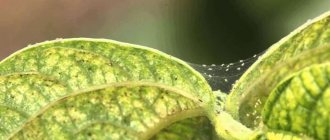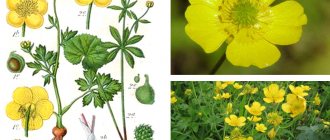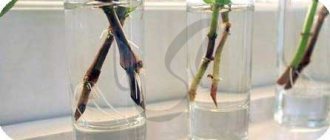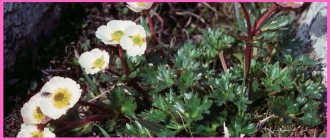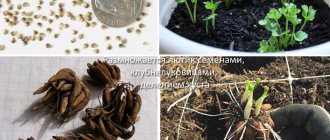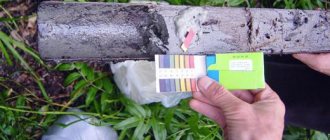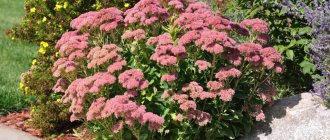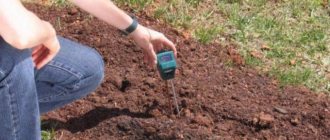Buttercup caustic
Acrid buttercup, popularly called stinging or gout herb and butterflower, is a perennial plant belonging to the Ranunculaceae family. Acrid buttercup is characterized by a straight stem 35-100 cm high, leaves with a five- or seven-fingered structure and bright yellow flowers located at the tips of the branches. The caustic buttercup blooms at the end of spring and beginning of summer. Acrid buttercup grows abundantly throughout the European part of Russia and is found in Ukraine and Belarus. The plant prefers well-lit areas and settles in fields and meadows. Can grow on muddy soil.
Properties and uses of buttercup
Traditional medicine does not use ranunculus. The herb, which, nevertheless, can be found for sale in pharmacies, is actively used in traditional medicine and homeopathy. The bulbs of the plant are also used. Homeopathy uses freshly harvested herbs. It contains protoanemonin. In small doses, this substance activates the central nervous system, increases the amount of hemoglobin in the blood, and fights harmful microbes. It is worth noting that the plant should be taken in this form only under the careful guidance and supervision of specialists in order to avoid burns.
Homeopathy also prescribes taking tinctures of buttercup bulbs for skin rashes, muscle pain, gout, irritations of the mucous membranes of the nose, mouth and eyes. Traditional medicine uses this property of the plant to combat warts and other skin formations, seals on the nail plates, constipation and other ailments. There are known cases of using caustic buttercup for furunculosis, abscesses and headaches. The plant is used to increase the overall tone of the body. In the old days, decoctions prepared from the flowers of the caustic buttercup were used for malaria, hernias, diseases of the gastrointestinal tract and tuberculosis. An ointment was prepared from the plant, which was used for toothaches and inflammation of the gums.
Eastern medicine uses ranunculus externally as a treatment for wounds, inflammatory processes and infectious lesions.
Folk recipes
- For heel spurs, we can recommend using the following medicine: carefully chop caustic buttercup (a glass), place in an enamel cup and pour two liters of boiling water. Leave covered for 15 minutes. Filter the solution from the flowers and soak your feet in the herbal infusion until the water cools. It relieves pain and inflammation well. The procedure is carried out until the spur completely disappears.
- Skin tuberculosis will be destroyed by lotions: prepare an infusion of 50 g of chopped herbs and half a liter of boiling water. Leave for three hours until the broth is strong. Moisten sterile gauze and apply to damaged areas.
- An ointment will cope with viral, colds and inflammatory diseases: take one part each of eucalyptus and ranunculus leaves (dry raw materials), mix with four parts of pork fat (melted). Grind the mixture in a wooden mortar until smooth. Rub into the chest and larynx area, then wrap in a woolen cloth and go to bed. Sessions are held daily.
Fresh buttercup (caustic) has a resolving and drawing effect. You can crush the leaves or grass and apply it to tumors, boils and abscesses. In the form of compresses they are used for headaches, mastitis and rheumatism.
Harmful effects of buttercup
If used ineptly or carelessly, caustic buttercup can cause severe damage to the mucous membranes of the larynx, mouth, nose and eyes. If plant juice gets under the skin, necrosis may occur - destruction of local cells.
Consumption of the plant can provoke fainting, weakening or acceleration of the pulse, cough, dizziness, and excessive vasoconstriction. If it enters the digestive system, ranunculus causes gastrointestinal disorders, diarrhea or colic.
If you are poisoned by this plant, you should immediately consult a doctor.
Buttercup poisoning
In addition to people keen on alternative medicine, children can also become victims of poisoning. A child, captivated by the beauty of nature, can pick buttercups as a gift for his mother. If the buttercup juice gets on the baby’s skin, it will begin to corrode it, and the baby will probably cry and start rubbing his eyes. It is important to prevent this, because the burning and pain can blind you. And if buttercup juice gets into your mouth, severe poisoning is unlikely to be avoided.
Even cattle are periodically poisoned by buttercups. Especially if the owner feeds the animals fresh grass, which these harmful flowers can easily get into. In well-dried grass, the toxic substance loses its harmful qualities.
When contacted with mucous membranes, the juice of caustic buttercup and poisonous buttercup leads to severe irritation. Under no circumstances should you inhale the aroma of the plant. If the juice or vapor hits the mucous membrane of the nose and eyes, it will instantly become inflamed. A cough and spasms in the throat appear, and the eyes become very watery. The nose reacts with a runny nose. And the eyes may temporarily lose the ability to see due to severe burning. If the juice of a poisonous herb gets on the skin, a burning sensation, itching occurs, followed by redness and swelling. Inflammation of the skin resembles urticaria in appearance.
In some cases, abscesses appear.
If the juice gets inside the body, not only the larynx becomes inflamed, but also the stomach and esophagus. Abdominal pain occurs, nausea with vomiting appears, as well as increased salivation and diarrhea. The person's pulse changes and sweating appears. If there was a lot of poison, then the nervous system suffers. Cramps and trembling appear in the muscles. The person may lose consciousness or become mildly delirious.
Read also The health benefits and harms of flax seeds
Chemical composition
The plant has an erect, hollow, hairy stem that branches at the top. It reaches a height of 30-70 cm; from the short rhizome of the burning herb, numerous roots arise, collected in a thick bunch. The basal leaves of the plant are 5-8 cm long, 5-7 palmate, the leaves of the stem are sessile and have linear lobes. The flowers of the caustic buttercup are bright yellow in color, about 2 cm in diameter, have five petals, and are located at the ends of the branches. This type of buttercup blooms in May-June, grows in arable lands, fields, and is often found in abundance in meadows, which poses a danger to livestock grazing there due to the protoanemonin contained in this grass.
This toxic, volatile substance upon contact provokes severe irritation of the skin and mucous membrane of the nasopharynx and eyes (can lead to temporary blindness), and if the fresh plant is consumed internally, it causes irritation of the gastrointestinal tract.
Harvesting of caustic buttercup occurs during the flowering period; after drying, the predominant part of the protoanemonin in the raw material disappears under the influence of high temperatures and dissipates when the grass dries. In small doses, this substance activates the activity of the central nervous system, counteracts microbes, and increases the concentration of red blood cells and hemoglobin in the blood. Also the composition of the burning herb includes:
- Saponins;
- Tannins;
- Glycosides;
- Flavonoids;
- Vitamin C;
- Carotenoids.
Kinds
The genus Ranunculus is divided into many varieties. In some taxonomic terms, there are about 400 plant species that are distributed throughout the globe, with the exception of Antarctica and the lowlands of the tropics. In the European part of Russia you can find about 40 species growing in the wild - multifloral buttercup, field buttercup, creeping buttercup, poisonous buttercup and others.
Asiatic
Asian ranunculus (Latin name Ranunculus asiaticus) is grown in many countries around the world. In nature, it can be found in the Mediterranean regions of South-West Asia and South-East Europe. There, plants are found in deserts, semi-arid areas, steppes, thickets, and forests.
Asian ranunculus is one of the most spectacular and versatile spring plants. This cold-loving species is primarily known for its unusual cultivars, which attract attention with lush flowers with delicate petals.
When grown correctly, Ranunculus asiaticus can grow up to 40 cm in height. The leaves of the species are pinnate and ovoid. Small flowers up to 5 cm in diameter are the greatest decoration. They are located on long stems, their colors are white, yellow, orange, and red. Two-color varieties (white-pink and yellow-violet) are available. Asian ranunculus blooms after the first spring rains. Flowering season: late May to early July. It is not resistant to our frosts - it needs to be wintered indoors.
Alpine
Alpine buttercup (Ranunculus alpestris L.) is a species found in the mountains of southern and central Europe. Perennial plant, size depends on environmental conditions. In damp, low areas, ranunculus forms lush clumps with large flowers and leaves. In dry places, illuminated by the sun, smaller.
The peduncle is 10-20 cm high. Small leaves grow from it. The leaves on the peduncle are even or three-lobed, arranged alternately. Leaf blades are round or kidney-shaped. One of the few species with white flowers. At the top of each peduncle grows a single white ranunculus flower with a diameter of 1-2 cm. The crown of the flower consists of 5 heart-shaped petals.
Caustic
Acrid buttercup (lat. Ranunculus acris L.) is a species inhabiting Europe, North Africa, Asia, and is also found in America (Greenland, Alaska). Perennial 30-90 cm high. In early spring it forms a rosette of leaves, followed by a branched peduncle, glabrous or pubescent. The species does not shoot like other species.
The stem is erect, branched, pubescent, with soft, dense hairs. Olive-colored leaves on long petioles. The flowers are yellow. The yellowish-green calyx consists of 5 tepals, 5 shiny petals, many stamens and pistils arranged in a spiral. The underground part is a rhizome with thick roots. Blooms from May to July.
Habitat of caustic ranunculus: meadows, forests, thickets. In wet meadows during the flowering period it gives the meadow a yellow color. The species is poisonous.
Borcefolia
Buttercup (Ranunculus aconitifolius L.) – the species is found in Europe. Cultivated in many countries as an ornamental plant. Perennial with erect shoots. Grows up to 60 cm in height. Grows in damp places in forests, ditches, meadows.
The leaves are palmate and toothed. The flowers are white, collected in loose, branched inflorescences, 10-20 mm in diameter. Sepals are reddish or purple. Blooms from May to August. Easy to grow. Propagated by sowing seeds (preferably immediately after collecting them), or by dividing overgrown bushes in spring or autumn. Watering is advisable during the flowering period. Grows best in well-drained, constantly moist soil in full sun or partial shade.
The species is cultivated for its beautiful flowers - single or double (for example, the Flore Pleno variety).
Photo. Variety of Borcefolia Ranunculus "Flore Pleno"
Multifloral
Ranunculus polyanthemos L. is found naturally in Europe, Western and Central Asia, and Siberia.
Perennial with slightly pubescent shoots. Grows up to 20-80 cm in height. The stem is erect, thicker at the base, and very branched. Has 3-8 leaves. The leaves are triangular, pentagonal-reniform, 3-6 cm long, 4-9 cm wide. Hairy on the underside. The base of the leaf is heart shaped. The flowers are shiny, collected in groups of 3-4, appear on the tips of the shoots, golden or light yellow in color, 20-30 mm in diameter. The bottom of the flower is pubescent.
Beneficial features
For medicinal purposes, all parts of the plant except the rhizome and roots are used in alternative medicine recipes. The healing properties of caustic buttercup have not found application in official medical practice, but folk healers recommend using the herb in the fight against skin defects (warts, boils, rashes, burns, etc.), rheumatism, muscle pain, gout, and neuralgic pain. Some healers prescribe preparations based on the fresh plant for internal use, but experts strongly disagree with such methods of treatment.
In alternative medicine, the beneficial properties of caustic buttercup are used to provide antimicrobial, analgesic, bactericidal, wound healing, diaphoretic, tonic and antipyretic effects.
Fresh herbs of this plant are used to make homeopathic medicines. Decoctions and infusions based on dried leaves and stems are used for inflammation of the bladder, liver, gastrointestinal lesions, respiratory viral diseases, toothache, dysentery, hardening of the spleen, Staphylococcus aureus. Dried and crushed flowers are used in folk medicine as abscess plaster or mustard plasters. Ranunculus flowers help with malaria, and in the case of rheumatic pain in the lower extremities they are included in remedies for rubbing sore joints.
Active Ingredients
The main component of the perennial weed is a caustic substance called anemonol, which causes watery eyes, swelling and a runny nose. The action is similar to camphor. The leaves contain useful vitamins and elements for humans: ascorbic acid, saponins, carotene, alkaloids.
Yellow flowers have a rich medicinal composition; they contain carotenoids that prevent the development of eye pathologies. Acrid buttercup contains coumarin. This substance is responsible for plasma coagulation, fights the formation of blood clots in blood vessels, and destroys cancer cells. And saponins found in the plant normalize blood pressure, reduce high fever, and help remove phlegm and bile.
Despite its toxicity, the herb exhibits wound-healing, anti-inflammatory, antimicrobial, tonic and mild analgesic effects. In folk medicine, tinctures were used to treat joints, dermatological diseases, skin lesions, rheumatism and gout.
Indications for use
In alternative medicine, the use of ranunculus is recommended for:
- Neuralgia;
- Rheumatism;
- Gout;
- Cystitis;
- Colds;
- Ascites;
- Malaria;
- Arthritis;
- Fever;
- Trophic ulcers;
- Constipation;
- Hernia;
- Arrhythmias;
- Furunculosis;
- Menstrual irregularities;
- Eczema;
- Scabies;
- Skin tuberculosis;
- Headache.
The plant is also used to remove warts, lipomas, and calluses.
Contraindications
The use of caustic buttercup is contraindicated for:
- Pregnancy;
- Hypersensitivity to the plant;
- Breastfeeding.
It is necessary to use products based on pungent herbs only after consulting your doctor, strictly adhering to the prescribed doses. It should be remembered that when fresh buttercup herb is consumed internally, severe irritation of the gastrointestinal mucosa occurs, accompanied by colic, nausea, diarrhea, profuse salivation, and tachycardia, tremors, and dizziness may also be observed. If such symptoms occur, you should try to induce vomiting, take activated charcoal and seek medical help.
The consequences of external skin damage upon contact with fresh grass usually disappear without leaving any traces.
Ranunculus acrid home remedies
For colds, diseases of the throat and mouth, and skin lesions, traditional healers recommend an infusion of caustic buttercup, for the preparation of which ½ tbsp. a spoonful of dried raw material is poured into a thermos and 0.5 liters of boiling water is poured in, left for an hour and then filtered. Use externally when treating wounds and boils, and also topically when gargling.
Article on the topic: Butcher's broom - useful properties, description
In the treatment of gout and rheumatism, a tincture of pungent herb is used, for the preparation of which 10 g of fresh plant flowers are infused in 100 ml of vodka in a dark place for a month. Used after straining to rub the affected areas.
For colds, severe coughs, and acute respiratory viral infections, use ranunculus ointment, consisting of 1 part of the plant's flowers and 4 parts of pork fat. The ointment is used for rubbing the chest and throat, after which it is advisable to cover the treated areas of skin with a woolen scarf overnight.
For muscle pain, use a tincture; to prepare it, 50 flowers of the plant are infused in 0.5 liters of alcohol for 21 days, filtered and rubbed into painful areas.
Buttercup (Ranunculus acris) or night blindness is a herbaceous plant from the perennial Buttercup family Ranunculaceae. It was first studied in 1597 under the name (f. hortensis Mart.) This flower can most often be found in the temperate zone of the entire Northern Hemisphere. It blooms from early May to June. The main places for frequent habitat of this very unpretentious and beautiful plant: sunny meadows, arable lands. The banks of many bodies of water. The flower has a very short rhizome, from which smooth, straight, hollow stems develop up to 50 cm in height (sometimes up to 120 cm).
The stems of the Ranunculus acris plant are branched and slightly pubescent. At the tips of the branches there are very bright and golden-yellow flowers, about 1-2 cm in diameter. Each flower has 5 petals, 0.7-1 cm in size. There are five stamens, as well as petals. The fruit has the appearance of a ball-shaped nut. Its average length is about 2 mm. The leaves may look different. Basal leaves 5-7 palmate on long cuttings; their lobes are irregularly notched or serrated-sharp. Leaves growing on the stem, sessile tightly, in the form of linear lobes have a more regular structure. Since the flower grows mainly in wild meadows, it is very dangerous for grazing livestock (very poisonous). But when dried, toxic substances become completely non-hazardous and plant hay is quite suitable for animal food.
Elena's Buttercup
Ranunculaceae family Ranunculaceae Ranunculus helenae Albov, 1891
Why is it listed in the Red Book?
Category and status . 2 “Vulnerable” – 2, UV. A narrowly local endemic of Western Transcaucasia.
Global Threat Category on the IUCN Red List
Not included in the IUCN Red List.
Category according to IUCN Red List criteria
Regional populations belong to the rarity category “Vulnerable” – Vulnerable, VU C2a(i); V. V. Akatov.
Brief morphological characteristics
Herbaceous polycarpic. Height – up to 10 cm. Rhizome oblique, brown. Stems ascending, thin. The basal leaves are long-petiolate, broadly ovate or almost round, coarsely toothed at the top; stem - oblong-ovate or lanceolate-linear.
The sepals are protruding, almost membranous, yellowish. Petals are narrowly obovate, longer than the sepals, narrowed at the base. Fruitlets number 5–6, irregularly ovoid, swollen, glabrous or small-glandular; the terminal spout is short, thin, almost curved.
Spreading
General range: Western Transcaucasia [1–3]: Gagra massif, Mount Kutysh (29.VII.1905, Voronov) [4], Mount Arabica (30.VII.1905, Voronov) [4], Shratovaya Valley (14.VII .1962, M. Sokhadze) [3], Ortobalagan valley (16.VII.1962), ur. Pršhe (4.VIII.1905, Voronov) [4], archive. Berchil (VII.22.1928, Sakharov) [4], Atsgyrkha (VIII.23.1929, Panyutin) [4], upper river. Psou, spurs of the ridge. Katsihra, Mount Ah-Ag (VIII.1939, A. Kolakovsky), Bzybsky ridge. (VI.1889–1892, Albov), Mount Napra (20.VII.1935, A. Kolakovsky), Akugura (16.VII.1934, Rukhadze), Mount Dzyshra (28.VII.1935, A. Kolakovsky), ridge .Askhi (20.VII.1937, A. Kolakovsky, Panyutin); Svaneti: upper reaches of the river. Kheledula (14.VIII.1979, Mukbaiani and others)[3], Mount Chypshira (6.IX.1902, Voronov)[4].
Russia: Northern Caucasus (RA: Murzikal plateau (1929, Troitsky and Pletnev)[5], Mount Guzeripl (6.VII.1928, Leskov)[4], Mount Oshten (12.VII.1935, Vasilyev; 20.VII. 1949, Kharkevich) [4], Pshekhasu); QC [5–8]; KCR [10].
Krasnodar Territory: Western Caucasus: Belo-Labinsky district (Mount Fisht, in the upper reaches of the Pshekhachikha River (19.VIII.1929, Leskov, Rusaleev) [4], Mount Fisht (17.VII.1912, Sosnovsky) [5] ); Western Transcaucasia: Tuapse-Adler district (Aibga ridge (9.VII.1940, A. Kolakovsky) [3, 6–9]).
Features of biology, ecology and phytocenology
Blooms in June – July. Entomophile. Mesophyte, heliophyte, microtherm. Obligate calciphile. It grows in long-snow habitats, screes, and gravelly slopes in the alpine belt [1,8]. Stenotopic view. Edifier and assectator.
Number and its trends
It is rare, but populations can be large. The density per 1 m2 can reach up to 60 individuals. Population dynamics are unknown.
Limiting factors
Extremely limited range. In all habitats they are periodically exposed to livestock grazing and recreation. Plans for intensive recreational development of high-mountain regions are of particular concern. The number may also be affected by climate warming and the reduction of snow-covered habitats.
Security measures
Protected on the territory of the KSPBZ and SNP. It is necessary to monitor the state of populations, strict adherence to the reserve regime, the creation of a protective zone of the reserve along its borders, and strict regulation of recreational activities.
Sources of information: Red Book of the Krasnodar Territory
1. Ovchinnikov, 1937; 2. Adzinba, 2000; 3. Adzinba, 1987; 4.LE; 5. Herbarium of the Institute of Botany of Georgia; 6. Altukhov, 1971b; 7. Alper, 1960; 8. Litvinskaya, 2001a; 9. CSR; 10. Galushko, 1978. Compiled. V. V. Akatov; photo by S. A. Litvinskaya.
1. Ranunculus hairifolia Red Book of Moscow
AOF | 10/29/2015 08:26:07
Back forward
Preparation and storage of buttercup
Most often, almost all parts of this plant are used (except for the roots): leaves, stems, seeds. When preparing raw materials, you must not forget about safety - Buttercup is poisonous and it is advisable to collect it with gloves, carefully cutting it with scissors and putting it in a basket. Harvesting occurs when ripe fruits have already formed, but the flowers are still visible. Plants must be placed in the shade, in a dry and ventilated place. It is strictly forbidden to dry the plant in the scorching sun, otherwise all the beneficial substances will die. It is not advisable to chop the stems and flowers before drying. After drying, they easily grind into dust. Store collected and dried raw materials, preferably in paper bags, in dark and dry closets, for no more than 1 year. Fresh raw materials (greens) are used immediately after collection.
Use in everyday life
In everyday life, peasants use Buttercup hay as livestock feed (after complete drying, the grass loses its toxic properties). Tinctures from Buttercup are used in magic as a strong poison. For various rituals and preparation of magical decoctions. In scientific medicine, after numerous experiments, the effect of using the plant for skin tuberculosis has been proven.
How to prepare and store ranunculus
Usually all parts of this medicinal weed are used, except the root: seeds, stems, leaves, flowers. You need to collect it with gloves - carefully cut it and put it in the basket. Harvesting occurs when ripe fruits form, when the rapid flowering of buttercup begins - in May-July. Then the collected grass is laid out in the shade, in a dry place with good air ventilation.
Under no circumstances should you dry buttercup under the scorching rays of the sun, otherwise the herb will lose all its healing properties. Before drying, you should not grind the grass, as once it dries, it will turn into dust. Store dried raw materials in paper bags for no more than a year, in a dry, dark place. You can use freshly harvested grass.
Composition and medicinal properties of buttercup
- The main toxic substance in Buttercup is protoanemonin protoanemonic (hydroxyvinyl acrylic acid lactone). It is an oily liquid with an unpleasant odor and a burning, scalding taste. The connection is not stable and becomes inactive after a short time.
- The fruits of the plant contain fatty oils. The aerial (upper) part of Buttercup contains alkaloids (alkali), salonins, cardiac glycosides, carotene, vitamin C, tannins, Asparagus asparagine, L-Arginine arginine.
- Protoanemonin, contained in the plant, reduces the strength and heart rate of muscle contractions. Can cause short-term vasospasm. At small doses, the substance increases the number of red blood cells and activates the central nervous system.
- Preparations using Buttercup components have an antifungal effect. They have antibacterial activity against dangerous Escherichia coli and viral staphylococcus (Staphylococcus).
- A large amount of carotene in Buttercup exhibits its anti-tuberculosis properties.
- An element such as coumarin, which is present in the plant, prevents blood clotting, inhibits the development of cancer cells, accelerates the healing of wounds, saturates the body with vitamin P, and is an effective prevention of the formation of blood clots.
- Saponins in the greens of the plant: remove phlegm, relieve fever, help remove excess bile from the body, lower blood pressure.
- Tinctures from Buttercup are used as an external remedy (lottion) in the treatment of wounds, boils (lat. furunculus) and joint diseases (in the elderly).
- Tannins form a biological film that protects cell tissue from chemical, bacterial and mechanical influence. Strengthens and narrows weakened blood vessels.
Article on the topic: Cuckoo's tears - useful properties, description
The use of buttercup in folk medicine
The freshest buttercup herb (Ranunculus acris) is used only for external use; decoctions are mainly prepared from the plant for lotions, compresses and washing.
Buttercup decoction for heel spurs
Place 1 cup of chopped (chopped) greens in an enamel saucepan, pour 2 liters of boiling water and brew for 10 minutes. Pour all the contents into a basin and steam the legs until the water becomes cold.
Lotions from buttercup infusion for skin tuberculosis
To prepare the infusion, you need to take 3 tbsp. spoons of finely chopped Buttercup and pour 0.5 liters of boiling water. Leave for 3 hours. Use on the skin as compresses.
Tincture of ranunculus flowers for umbilical hernia
This tincture is prepared only from white buttercup flowers. 50 g of flowers, pour 0.5 liters of vodka and leave for 7 days in a dark place (in a cabinet). Take 1 tbsp. spoon before eating.
Infusion of buttercup herb for internal and external use for skin diseases, difficult to heal wounds and colds
To prepare the infusion, you need to take 1/2 cup of dried Buttercup raw material, place it in a thermos flask and pour 0.5 liters of boiling water. Leave for 3 hours, then strain through gauze and rinse the wound with this solution. For internal use, the dosage is 1 tbsp. spoon 3 times a day. The same solution can be used to gargle a sore throat.
Tincture of buttercup extract for muscle pain, sore throat and hair rinse
You need to take 50 fresh Lyutka flowers, pour in 0.5 liters of medical alcohol, grind thoroughly and leave in the dark for 3 weeks. Filter the tincture through gauze or a bandage. Ingestion is strictly contraindicated. Use for external rubbing and compresses.
Ointment from ranunculus flowers for colds, viral diseases and inflammation of the lymph nodes
Take one part of the plant's flowers, 1 part of dried Eucalyptus leaves (Eucalyptus) and 4 parts of rendered pork fat. The mixture is thoroughly ground until a homogeneous soft mass is obtained. The ointment should be rubbed on the patient’s chest and throat, then wrapped tightly in a woolen scarf and shawl for bed. Treatment is carried out daily until complete recovery.
Buttercup juice for toothache and eye cataracts
Juice is extracted from fresh herbs and flowers of the plant. A cotton swab moistened with juice is applied to the painful tooth. For cataracts, it is enough to wipe the eye with juice several times a day.
Tincture for gout and rheumatism
Fresh Buttercup flowers (10 g), pour 100 g of vodka and leave in a dark place for 1 month. Strain the tincture and use as compresses.
Buttercup decoction for liver diseases
Herb plant - (1 teaspoon), pour boiling boiling water over it, then place it in a water bath (saucepan with a bowl) for 15 minutes. The broth must be cooled, strained and consumed daily, 1.5 teaspoons before meals.
Recommendations for use from homeopaths
Unfortunately, official science has not yet used buttercup (see the photo of the weed in the article) in pharmaceuticals. Much has been written about the healing effect of the plant in ancient chronicles. The physician of the Austrian Emperor Ferdinand I also mentioned its properties and recommended its use for warts.
Usually the raw materials were used as lotions, wraps and compresses, although internal use is also possible. You just need to do this with great caution, knowing the exact dosage. There is evidence that water tinctures are used for liver diseases, intestinal disorders, rabies and malaria.
However, you should not carry out dangerous therapy yourself; even modern doctors rarely do this, preferring external use. The crushed parts relieve pain in the joints (using rubbing), disinfect and destroy harmful bacteria on the skin.


